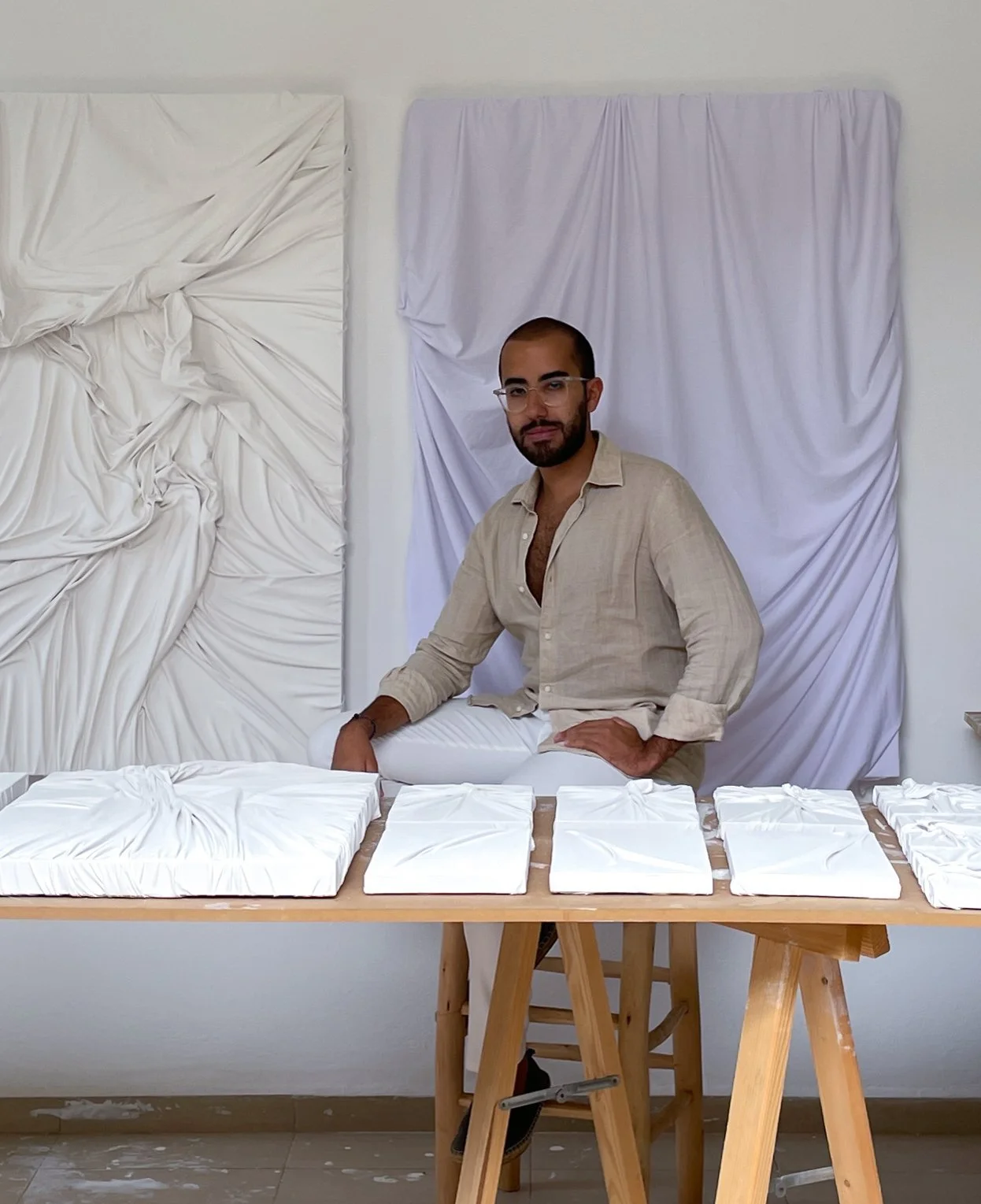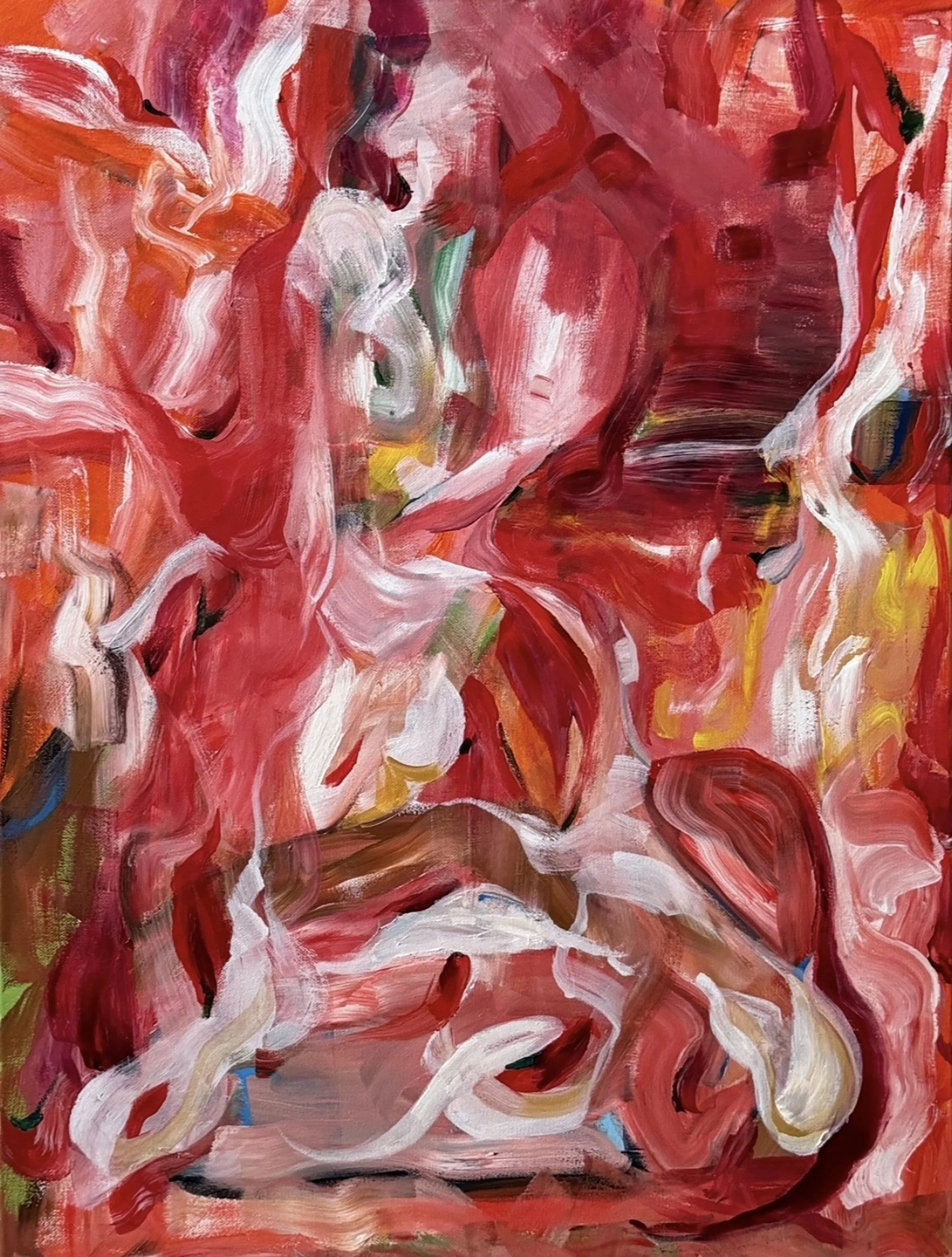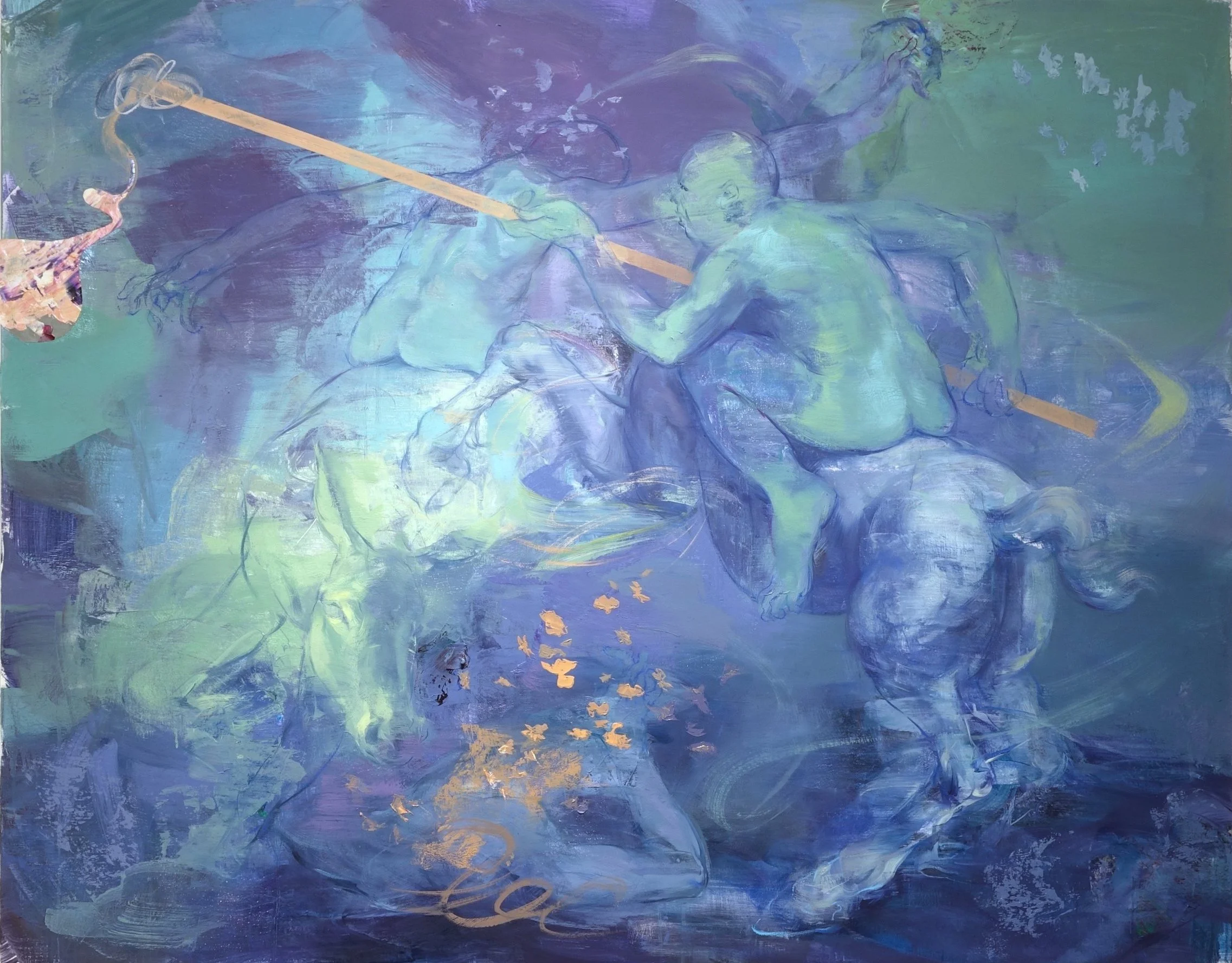10 Questions with Oussama Garti
Oussama Garti, born in Rabat, is a Moroccan architectural designer and artist trained at the Architectural Association in London. Fascinated by the infinite amount of similarities between macro and micro elements around him, Garti explores the idea of perception and works with extensive research to produce his work. His environment and observations fuel his creative process. He also uses numerous tools to explore remote locations and builds a digital library of natural textures in different scales. He magnifies “moments” and celebrates their complexity on his canvas. With his immersive work, Oussama Garti takes us on a journey full of poetry and lyricism.
In “Odyssey”, the artist paints portions of the ocean to stress the importance of Ocean Colour that has been changing in the last centuries due to Climate Change.
His latest body of work, “Ripples”, came after a series of small studies exploring the strong interrelation between emotions and movement. He then questions the abstract spaces generated with every motion and chain reaction that comes after it as he stretches fabric on top of his canvas before freezing it.
Oussama is also the co-founder of INTERVAL, a non-profit cultural initiative that aims to widen access to art, invite different actors to debate around a range of topics, and support projects with high social impact in the MENA region.
Oussama Garti Portrait
ARTIST STATEMENT
Oussama Garti tries to capture moments and emotions he deems are crucial to 'trap' in his canvas. For his body of work, "Ripples. The artist sculpts drapes using fabric, needles, and many layers of liquified plaster that he then carefully sands. Surrounded by his family during the quarantine, the artist spent a long time studying and sketching their hand gestures.
Filled with emotions, our gestures are much more than just mere movements but a secret language that doesn't need words to communicate our feelings. Oussama then explores the idea of freezing these very same emotions into his canvas by recreating the movements. Capturing and releasing the emotion into each canvas is his own understanding of a moment in time and the energy it held.
Translating these moments into a medium he specifically imagined for this body of work, he hopes to stress the extent and implications our actions, words, or gestures have. When the fabric is pulled or released in one area, a chain reaction is followed that affects the rest of the canvas. Chain reactions we rarely are aware of or grasp in our lives.
Each work serves as a memento of a specific moment that lasted an instant and seemed insignificant but is far-reaching.
INTERVIEW
When did you start experimenting with painting, and when did you decide to become an artist?
I started painting very early, at five years old. I joined an art studio based in Casablanca at 11. All my free time was devoted to painting and drawing during my childhood. I had a complex love/hate relationship with art at that point, and it was only when I reached 18 that I realized that it was the best tool for me to express myself.
The early years were about replicating master paintings and learning a range of techniques using mainly oil paint. It took me a long time to be able to develop my own ideas and (somewhat) know what I wanted to share. I think art is a special way of trying to learn more about yourself which can sometimes be either beautiful or painful. Studying art in Paris then architecture at the Architectural Association School in London enabled me to become critical about my ideas and take them further than I thought I could.
What was the biggest lesson you learned while trying to become an artist?
It's probably that you only become one when you are true to yourself when producing work that looks like you. It is probably the hardest thing for anyone and might take a lifetime.
The Creation, Sculpted drapery, 50x90 cm each (Diptyque), 2021 © Oussama Garti
What about your inspiration? What artists influence and inspire your work the most?
I believe that everything around us should inspire us. If you go with the idea that what you produce is you in a way, your inspirations also need to be part of your everyday life. I learned to marvel at what surrounds me and find beauty in it. As one of my art teachers once said, "You produce who you are," so I decided to surround myself with beauty to be able to produce it.
I, of course, also have a list of artists whose work I go back to and find extremely inspiring; Helen Frankenthaler, Claude Monet, Mark Rothko, Piero Manzoni, Clyfford Still, Barnett Newmann, Robert Motherwell, Willem De Kooning, amongst others.
How would you describe your creative process? Where do you start when creating a new painting?
I don't really have a set of rules when it comes to producing work. Sometimes it can be spontaneous and sometimes thoroughly planned. It really depends on what I am trying to share. "Ripples" is about emotions and needs to come from within. While "Odyssey" is capturing ocean color with a very specific intention and must be carefully prepared beforehand
What are the essential elements in your art? And how did you evolve this way of working?
The key element in my work is capturing moments in space and magnifying them. As an Architect, I tend to think spatially and give a lot of attention to details.
I use different tools to explore remote locations and generate a library of textures, maps, topographies, etc. By attempting to blur the border between Macro and Micro, I celebrate the complexity of these moments on my canvas. Each work serves as a memento of a specific moment that lasted an instant and seemed insignificant but is far-reaching.
Chant V, Acrylic on Canvas, 200x130 cm, 2019 © Oussama Garti
Réunion, Acrylic on Canvas, 200x130cm, 2019 © Oussama Garti
Your latest series, Ripples, explores hand gestures captured on canvas through fabric and needles. How did you develop this project?
When surrounded by my family during the quarantine, I spent a long time studying and sketching their hand gestures.
Filled with emotions, our gestures are much more than just mere movements but a secret language that doesn't need words to communicate our feelings. I then explored the idea of freezing these very same emotions into the canvas by recreating the movements.
Capturing and releasing the emotion into each canvas is the artist's own understanding of a moment in time and the energy it held.
Translating these moments into a medium I specifically imagined for this body of work, I hope to stress the extent and implications of our actions, words or gestures. When the fabric is pulled or released in one area, a chain reaction is followed that affects the rest of the canvas. We rarely are aware of chain reactions or give importance to in our lives, with the same idea that each piece works as a memento of particular moments.
Colors seem to have a precise meaning in your work. In Ripples, the canvases are entirely white, while the Odyssey series presents different shades of blue. How do you choose your colors, and what meaning do they have for you and your work?
I only use color when it can convey some meaning or add another layer of complexity to the work. In "Ripples", I felt like there was no need to add color as I wanted the viewer to focus on the movement of the drapes only and feel the emotion that comes from it. Color would have distracted. But I am thinking of creating monochromes of other colors, but again for a specific reason.
On the other hand, "Odyssey" is about bringing attention to an extremely important subject which is ocean color. Ocean color has been changing in the last century because of climate change and we need more people studying this change as it can tell us a lot about the health of our oceans. My paintings capture "plots" of the water in an attempt to archive and change our perception of Ocean Color.
Passion, Sculpted drapery, 130x90 cm, 2021 © Oussama Garti
Still IV , Sculpted drapery, 30x20 cm, 2021 © Oussama Garti
Vivid, Sculpted drapery, 60x80 cm, 2021 © Oussama Garti
What do you think about the art community and market? And how did your perception change over the last year due to the pandemic?
Times are changing and art is now being consumed differently. Social platforms such as Instagram are definitely helping younger artists display their work. It has now become a critical tool to be familiar with. These platforms became even more important during the pandemic. To be honest, I wondered if the art world would survive such difficult times, but I was astonished by how people came together to create new innovative projects. I actually co-founded during the pandemic with three other art-enthusiasts; Amina Debbiche, Omar Benmoussa, and Hamza Slaoui, "INTERVAL", a non-profit cultural initiative that aims to widen access to art, invite different actors to debate around a range of topics, and support projects with high social impact in the MENA region. I will always be grateful for the people I met during the pandemic and who were part of this effort to rethink how we engage and experience art.
Retrouvailles, Acrylic on Canvas, 200x130cm, 2019 © Oussama Garti
What are your thoughts on digital presentations, like fairs and exhibitions, for artists? Do you think these are good opportunities for young artists like yourself?
They can definitely help. With "INTERVAL", we built a virtual exhibition that brought together amazing Moroccan artists such as Yto Barrada, who exhibited at the MoMA and Pace Gallery numerous times, as well as Said Afifi, Amine El Gotaibi, Yasmine Hatimi, Morran Ben Lahcen, M'hammed Kilito, Safaa Erruas, to name a few. The exhibition was a total success and was very well received by the public and the art community.
But Art has this very important human dimension. My work, for example, is meant to be immersive and has a greater effect when standing in front of it than through a screen.
Finally, what are your plans for the future? Any exciting projects, exhibitions, or collaborations you are looking forward to?
I am looking forward to continuing to explore the different series I am currently working on.
But I am also looking forward to my next two exhibitions in Europe this year, and I am working tirelessly to be able to convey all the ideas that I want to share with the viewer.


























